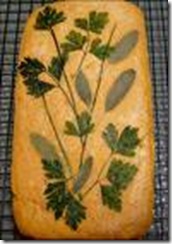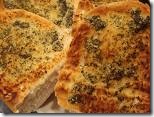Blog Archives
Herb Breads for Winter Warmth
As I write I’ve a small pan of orange peel and caraway seed simmering on the woodstove in brown sugar. Mixed in with flour and yeast it will grow into a sweet caraway “quick bread”…leaving a lingering fragrance to clear stuffy winter air. The “breads of winter” are nurturing medicine, especially when herbs are added.
Did you know that some herbs and spices actually encourage the activity of yeast? Try ginger, caraway, cardamom, cloves, mace, nutmeg, or thyme to give your dough an extra lift. Small amounts of cinnamon help too, just limit it to no more than 1/4 teaspoon to a cup of flour (more than that inhibits the yeast). As tempting as it may be to experiment with adding dry mustard – don’t. Its a yeast killer.
Though fenugreek and rosemary don’t enhance yeast growth, they will act as a preservative. If you toss a sprig of rosemary on your baking sheet it will scent the loaf and the air. Remember, the scent of rosemary is supposed to be a memory-stimulant. Traditionally, rosemary was burned by the beds of sick patients,in some hospitals it was combined with juniper berries to purify the air and prevent infection. Yet another reason to fill the kitchen with that delicious rosemary.
And don’t forget decorating the top of the loaf with seeds. Either gently push into the bread before baking or brush the top with egg white/water and sprinkle. In addition to sesame and poppy seed, start collecting the seed from your catnip plants,clean them and use as you would poppy seeds. They give a subtle minty flavor. Very nice on a lemon bread. Experiment with licorice flavored anise or fennel seeds, celery seeds (great on bread sticks used for dips). Its fine to mix the seeds into the dough, either whole or ground.
An interesting seed to add to your bread is Milk Thistle (Silybum marianum). Russian scientists studied adding it to breads to learn how it might affect the metabolism. Well, it turns out that Milk Thistle bread exerted a general restorative influence, increasing internal protection resources, capacity for work and vital activity. ( Gil’miiarov et al. 1998). I’ve no idea how much was used, perhaps calculating doses by the slice? Also, I would crush or grind the seed first.
Here’s another tip–for hop’s growers–put some of those hops aside for your baking. Grind your cones into a powder and infuse it. When it cools enough, add your bread yeast to it. You won’t have to knead as long to get an exquisite texture into your bread.
Remember to make up some herbal butters for your breads and top breads with garlic, basil, rosemary, oregano and parmesan as seen to the right.
Add some sage to your bread dough and scones. If you use thyme, go easy, its very strong.
Fresh herbs are best but in baking, dried herbs are just fine; use 1/3 to 1/2 of the fresh herb measurement.
Since I’m talking “food medicine” I really ought to point out that wheat is another fabulous medicinal food. Just be sure its whole grain and NOT gmo. The book 101 Foods that Could Save Your Life, by David Grotto tells us the following about whole grains:
Longevity: Eating whole grains is associated with longevity and lower risk of many different types of disease in women.
Heart Health: Several studies show reduction in cholesterol and triglycerides when whole grains, as opposed to refined grains, are part of the diet.
Rheumatoid Arthritis: A study of rheumatoid arthritis patients who were given a fermented wheat germ extract in addition to their steroid therapies found significant improvement compared to steroid use alone.
Cancer: A meta-analysis revealed that there is an inverse relationship between whole grain consumption and colorectal, gastric,and endometrial cancers.
Diabetes: People who consume at least three servings a day of whole grain foods are less likely to develop type 2 diabetes than those who consume less. In a study of nearly 3,000 middle-aged adults, whole grain consumption was associated with lower levels of total and LDL cholesterol, and improved insulin sensitivity. Fasting insulin was ten percent lower when whole grains were consumed versus when refined grains were eaten.
Obesity: According to a study in the American Journal of Clinical Nutrition, people who consumed the most whole grain foods had a lower body mass index (BMI).
To get the most out of your grains, soak them before using them. The reason being that all grains contain phytates which interfere with absorption of calcium, magnesium, copper, iron and especially zinc. Traditionally folks knew to soak their grains overnight. According to the Weston Price Foundation, soaking grains in warm acidulated water for as little as seven hours will neutralize most of the phytates. What this means for “medicinal herbal bread making” is that we use sour dough or the overnight sponge method. If you grind your own grain, an even better approach is to soak it whole, dry it and grind it. If it starts to sprout a little it gives a pleasant malty flavor that delights yeasts. Whole grains are also a lot easier to grind if you’ll soak, dry, then grind.
Eating a lot of unfermented grains, due to these phytates, is connected to bone loss and mineral deficiencies. An occasional “quickie” bread of regular flour is ok, but do make an effort towards slow food whole grain fermentation before baking or eating.
Now then, would like the recipe for the sweet caraway bread?
Sweet Caraway Batter Bread
Prep Time: 45 minutes
Cook Time: 45 minutes
Ingredients:
1 cup water
2 tbsp brown sugar
1 tbsp butter
1 tbsp grated orange peel
1 tsp caraway seeds
.1/4 cup milk
2-1/4 tsp active dry yeast
1 tsp salt
2-2/3 cups bread flour
Preparation:
In small saucepan, boil the water, brown sugar, butter, orange peel, and caraway seeds for 3 minutes. Remove from heat and let cool until lukewarm.
Pour boiled liquids in bowl. Mix in milk, yeast, and salt. Stir until yeast is dissolved.
Mix in flour.
Cover bowl with clean kitchen towel or plastic wrap and let rise in warm place for 30 minutes.
Stir down batter.
Scrape batter into a greased bread pan, 9x5x3 inches. Cover and let rise in warm place for another 30 minutes or until double in size.
Bake at 375 degrees for 45 minutes or until bread sounds hollow when tapped on.
Remove loaf from pan and let cool.


